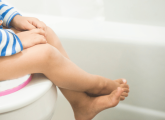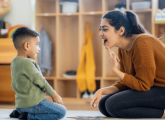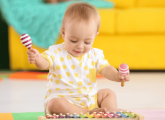Little learning opportunities can go a long way. With a bit of imagination, play on a miniature scale can support children’s development across the EYFS, says Anna Ranson…
Small world play is a fantastic tool for supporting children’s development in the Early Years.
Used as a story prompt or scene for the retelling of a favourite book, it can be invaluable in helping young children make sense of literacy in a kinaesthetic way.
By adding a few extra materials to the mix it’s possible to extend the learning even further and incorporate all areas of the EYFS – from Understanding the World to Personal, Social and Emotional Development.
This approach can be used effectively as a tool for children’s self-assessment at the same time.
With the huge set of requirements placed on Early Years practitioners today and the wide range of activities going on in our settings, it’s easy for small world play to become neglected and stale.
However, with the addition of a few stock items to the resource cupboard, which can be reused in a variety of ways, it’s easy to inject it with new life and make it an exciting, creative option for children to access once more.
A good place to start is by making a quick assessment of the interests, gender-balance and abilities of your current cohort.
Are there certain children or small groups who are more reluctant when it comes to storytelling or imaginative play?
Are there some with a burning passion for dinosaurs or robots, fairies or all things creepy-crawly? Are there some fans of particular story characters?
You can draw up a list of small world play ideas based around these themes, and plan to set up a few separate scenes to match them over the following months.
Even better, ask the children to contribute their own ideas and get planning using clipboards. Next, take a look at the resources you have and try adding some new, loose materials to the collection that can be brought out quickly to change an area.
The following items are really useful additions for getting started with small world scenes:
● Large, shallow tubs – e.g. Tuff spots, underbed storage boxes, cat litter trays, Tubtrugs.
● Car tyres, wooden barrels or large plant pots, for outdoor small world set-ups.
● Dried moss or lichen.
● Large rocks and pebbles.
● Sand and soil.
● Aquarium gravel and shells.
● Tree branches.
● Dried pulses.
● Small animals, sea creatures, buildings, dinosaurs, figures, cars.
● Small house plants.
● Fabric and play silks.
Here are a few favourite small world play scenes we have set up and enjoyed that could be good starting points to springboard your own planning.
The sky’s the limit with small world play – any story, character, theme, habitat, or real-life experience can be created with simple materials and toys with a little imagination!
Dinosaur land
Use a shallow, flat container such as a Tuff spot or a cat litter tray and fill it with a range of sensory play materials. For example, use dry beans and rice, small pebbles and rocks, and twigs and small branches.
Use some brown playdough to represent mud in one corner, and use this as a base to stick real or fabric plants into.
You could create a volcano from recycled packaging covered with crumpled paper and stuffed with a piece of orange material. Add small toy dinosaurs and play!
Try adding some favourite dinosaur books to a shelf below the play or next to it in a basket. Add dinosaur-shaped blank books and some pens for free role-play writing prompts.
Rock pool
After a trip to the beach or during a summer seaside-themed project it’s fantastic to introduce a little rock pool small world set-up.
Use the water table or a large Tubtrug embedded in a corner of the outdoor area, and line the base with sand.
Fill it three-quarters full of water and add large rocks, shells and pebbles to create your own rock pool.
Introduce toy sea creatures such as crabs, star fish and small fish. Adding a fishing net, bucket and spade provides an opportunity for developing it into role play.
You can even make a whole beach scene with deck chairs, an umbrella and beach ball!
For many inner-city kids, this could be the closest they will get to the beach over the summer.
Lunar landscape
For space-lovers, creating a moon surface is so much fun – and it’s relatively easy to put together with recycled materials and the added sensory fun of homemade ‘moon dust’!
Inside a large, shallow box or Tuff spot, tape down some large egg cartons and other pieces of cardboard packaging to make a bumpy crater surface. Cover this with tin foil, taping it down underneath.
Add some smooth, white rocks and pebbles, and any moon-themed small toys you might have such as a rocket, astronauts and moon buggy.
Mix up some home-made moon-dust by adding a few drops of black food colouring to a large bag of salt and shaking it in the bag until the colour has dispersed evenly.
Add in a tablespoon of talcum powder and some silver glitter, and spread it out to dry. It should be light grey, fluffy, sparkly and oh so soft.
Spread this over the moon craters and play!
Again, add space-related story and non-fiction books nearby, and make rocket-shaped blank books for mark making.
Putting out some lolly sticks, green card and googly eyes on the creative table may inspire some children to make and add their own aliens to the play scene.
Frog pond
Cut a pond shape from a foam sheet and add little green lily pads from the same material or pieces of felt.
Use natural tree branches or small logs to surround it, adding foliage, moss, rocks and any other natural materials from the collection.
Use little toy frogs to jump in the pond, sing ‘Five Speckled Frogs’ and retell favourite frog stories.
If you add some bubble wrap with black dots marked on using a permanent pen, they can lay their own frogspawn too!
This is the sort of small world that the children can add to as they play, looking up in books and the internet what other creatures might live around a British pond, They can then either find or make those to add to the area.
Sticking a poster of a frog life-cycle in the background can increase the learning opportunities further.
Fairy garden
Incorporate small world play into a real, living garden space to ignite creativity and take the play outside!
Fill a garden barrel with soil, and plant a variety of bright flowers and little shrubs.
Add a flowerpot on its side, some branches and a little path made of pebbles to lead to the door.
The children could design and make any more additions they choose, from a pond area to little cork toadstools. Add toy fairies and unicorns to come to live in their new home, and let the play begin!
Placing large fabric scarves nearby to become wings will encourage imaginative role play.
Add favourite fairy books and little sticks dipped in glitter and glue at the tip to become fairy wands.
Farm
Use a toy barn or make one from a small cardboard box and place it, along with some favourite toy farm animals, in a large tray.
Use real materials to add a sensory play element to the scene, for example, dried beans and pulses, cut (or planted) grass and a tub of wet soil for the pigs to roll around in, and a little tub filled with water for a pond.
Adding fresh cut herbs such as rosemary and basil will enrich the sensory elements even further, and helps to aid the use of new vocabulary – such as ‘squelchy’ and ‘squishy’ – as children play.
Try adding a CD player nearby with animal noises and farm songs to play in the background.
Sports arena
Use toy figures to make up crowds and players in team sports events. This type of small world really appeals to those little football fanatics and can be so simple to set up, using a piece of green carpet or a small section of fake grass from the garden centre.
Add on the markings for whatever sport it represents and let them play!
To create an Olympic stadium you can add sand for a long jump and a tub of water to create a swimming pool too, for enriching sensory exploration and fun.
For added literacy encouragement, provide small labels and pens, and get children to design flags, signs and banners to be hung around the stadium.
Small rectangles of card could also be used for making entrance tickets with a single hole puncher for snipping them on entry – perfect for promoting fine motor development through play.
City in a cardboard box
Try changing the small world backdrop by presenting the scene within a large, shallow-sided cardboard box (a large appliance or furniture box works best).
Inside the box, start to draw a roadway system with pens and write a few simple labels, eg ‘road’, ‘shops’, ‘station’.
Encourage the children to finish the roadway and add more of their own labels and signs using pens and stickers.
Add cars, trains, figures and wooden blocks for constructing a city around the roads. The children can even climb inside to play, turning it into a full body, interactive small world experience!
Try adding a box of recycled cartons, tubes and boxes with some sellotape and scissors to encourage further designing and construction.
Make some challenge cards, which the children can select for an adult to read to them, for example, “Can you make a station for the trains?” or “Can you design a park and playground, then make it?”
Seven ideas to get even more out of your small world play offering…
1. Try adding sensory materials to enrich the play and increase vocabulary development.
2. Make interchangeable backdrops to simple scenes from cardboard painted with skies, a city-skyline, underwater, etc.
3. Store themed sets of small world toys in small containers or bags, labelled and ready to use.
4. Gather a small selection of books to match each theme and set it in a basket next to the small world scene.
5. Cut plain books from folded paper into a shape to match the theme, e.g. dinosaurs or rockets, and lay them nearby with a pot of pens to encourage pre-writing and storytelling through play.
6. Leave a digital camera near the small world scene and encourage the children to take photos of their play, which can then be printed and displayed on a board nearby. Children can then annotate these with their own marks, with the practitioner acting as a scribe underneath. These can be used to make story books about the small world scene to read to the whole class.
7. Ask the children to plan out their own small world scenes. Can they make a diagrammatic list of all the materials they will need, and then go to search for them to build it independently?
Anna Ranson is a primary teacher from the UK with a specialism in early years education and art. You can find lots more creative ideas at her website, The Imagination Tree.

Toilet training in schools – Time for a new approach?
Editors picks

Speech and language support – Resources for Early Years
Editors picks

Music in EYFS – How to make it meaningful
Editors picks
